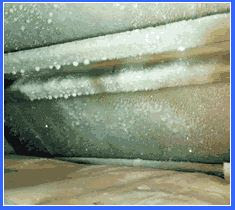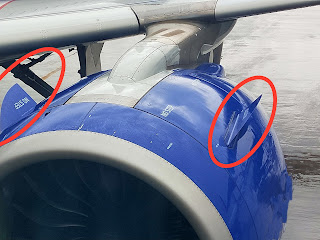Aircraft Insulation Blanket
Insulation blanket is heat and acoustic barrier.It is made
of fiberglass wool.Fiberglass wool filled between waterproof polyurethane covers
and edges are sealed to prevent water ingress.
Fig 1 Insulation Blanket on Fuselage Structure
Aircraft necessarily create a lot of unwanted noise. The main source of noise in aircraft are engines and air flow, which transits through the fuselage and overall structure. In order to make aircraft interior quieter, an insulation blanket used.
When aircraft at high altitude, the outside temperature is about -60-degree Fahrenheit. In combination with pressurization, aircraft insulation material helps keep the cabin warm by filling the space between the interior wall and the aircraft fuselage.
As we know that fire retardant material is must for all aircraft. The reason of choosing fire retardant material is to minimize the potential for a fire and help to prevent or slow flame spreads if a fire occur, which will provide maximum evacuation time and helps to ensure the safety of passengers and crew members. Although, It’s a requirement of regulator for manufacture that the interior material for aircraft should have self-extinguishing quality.
The following are the purpose of insulation blankets
1.Protect passengers from frigid condition at high altitude
2.Minimize loss of heat from the fuselage
3.Stop the formation of condensation and
4.Reduce noise level in cabin.
5.Protect electronics component from condensed
water.
6.It act as insulation material between fuselage
structure and electrical components.
Insulation blanket normally installed on fuselage structure in pressurized area.The Density of insulation blanket is vary depending on their location in an aircraft.This is determined by design requirement in order to comply with thermal and acoustic requirements of particular area.
Different thickness of insulation identified
according colour of insulation blanket.
Pink Blanket: Standard Thickness mainly used in economic class.
Green Blanket: Medium Thickness use in door and some area in cockpit.
Yellow Blanket: High Thickness use in Business and first class.
Additional Orange Cover Foil: Thermal Protection to protect the blanket from the heat produced by other systems.
Many times, passengers report water dripping in flight. Why this occur?
This is occurred due to condensation. Although air condition packs deliver dry air into cabin but due to human respiratory system air become humid.Most condensation on airplane structure occur during flight when the temperature of both the outside air and the structure are very cold.Structure temperature are usually below the dew point of the cabin air,causing some amount of condensation to form during most flights.In addition,because structure temperatures are normally below the freezing point of water, most condensation forms as frost.
Fig 2 Frost on Surface of Fuselage
The cabin air passes to cold structure through small gaps in the insulation coverage and passage around insulation blanket fasteners.
When aircraft start decent if condition allow temperature rise to above freezing point which cause frost melt,there will be sudden draining of water on crown area of fuselage and possible into passenger cabin.Although insulation blanket surface is waterproof which allow water to drain over bilge area in the belly of fuselage where it can drain overboard.However some water may leak through the gaps in insulation blanket which drips into the crown area of fuselage and possibly into passenger cabin.
Fig 3 Condensation Formation Cycle
Insulation blanket generally keep most of the water out of the crown area.
Although,We can not completely stop formation of condensation but as maintenance team How we can reduce formation of condensation and dripping of water into passenger cabin.
1.Whenever we do maintenance of component or system by removing insulation blanket, at the time of installation make sure that we should avoid exposed structure and excessive gap between the installation blanket which will decrease amount of condensation.
2.Ensuring that blanket joint areas, whether butt joints or overlaps are properly installed will also reduce the creation of condensation and subsequent water dripping into the crown area.
3.During installation of blanket fastener make sure we should not tear fasteners holes which may allow passage of cabin air.
Please Follow me and Join me on telegram there you can Share your Doubt.
https://t.me/joinchat/NxLqTH2cTX9hMjM1
You can also join me facebook group,link provided below
https://www.facebook.com/groups/304288677920172/?ref=share
Join us on instagram
https://www.instagram.com/invites/contact/?i=1tv1l3w2dcogj&utm_content=m7ttk5x
Youtube Channel






Superb info sir thank you so much
ReplyDeleteGreat info...
ReplyDeleteVery informative & useful content with all the required relevant information.
ReplyDeleteGreat information sir.. many thanks for your efforts.
ReplyDeleteGreat information sir
ReplyDelete